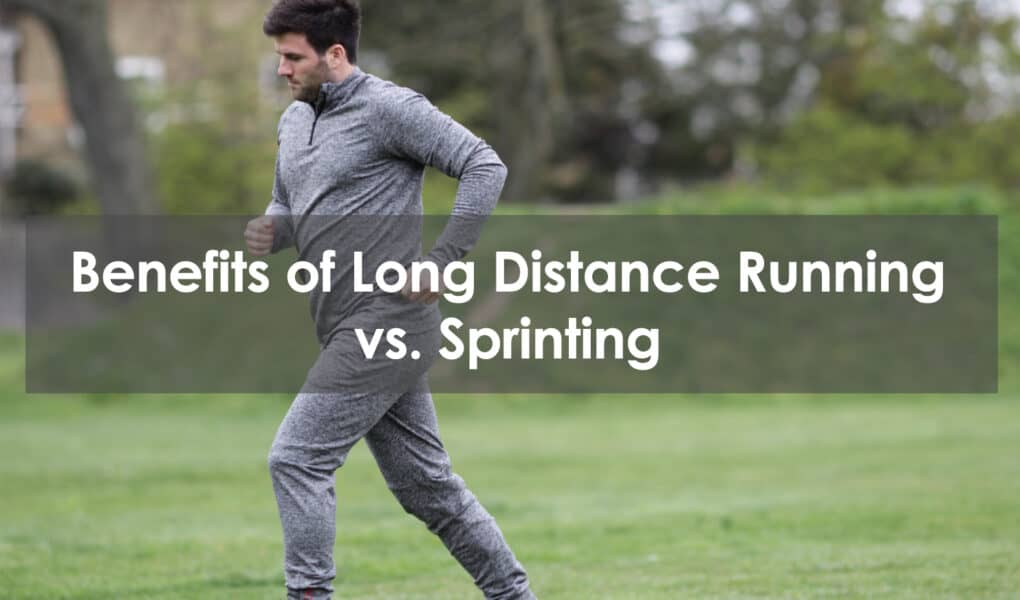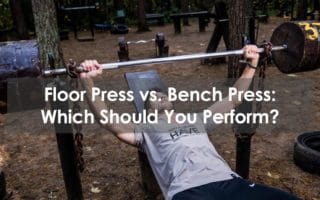Long-distance running and sprinting are the two extremes of the running world. The first is a form of aerobic exercise while the second is primarily anaerobic. Both of them will challenge and develop your body differently. But which is best?
In this article, we compare the benefits of distance running vs sprinting to determine which form of exercise is better.
What Sprinting Involves

Sprinting is a type of anaerobic exercise. It doesn’t require a lot of oxygen but sees you working at 80 to 95% of your maximum heart rate. It is very intense and can only be kept up for a short period of time. Generally, sprinters do not continue at their high pace for more than 200 m.
High-intensity sprints form the basis of HIIT training.
What Running Involves

Running involves moving at a moderate pace that allows you to sustain the activity for a long period of time. It requires a lot more oxygen and is a form of aerobic or cardio exercise. It is a good way to improve your cardiovascular health, bringing down your blood pressure and lowering your pulse rate.
Benefits of Sprinting
Time Efficient
The first benefit of sprinting over running is that it is far more time efficient. Sprinting workouts are usually completed within 20 to 30 minutes, whereas a running workout may involve several hours.
Speed Development
If your main goal is to increase your running speed, then sprinting is the way to go. It is the best way to enhance your explosive power and your muscle strength. There is also some evidence that running for more than half an hour can have a negative impact on a person’s ability to run fast.
Benefits of Running
Endurance
Long-distance running is by far the best way to develop your cardiovascular endurance. It will allow you to perform tasks for longer without getting puffed out.
Cardio Fitness
Running is a better form of cardio, doing a better job than sprinting at improving the efficiency of your heart and lungs. That is because it is more of an aerobic activity that places more constant and longer demands on the body’s circulation system.
Lower Injury Risk
Compared to sprinting, running has a lower injury risk. So if you are recovering from injury, or are prone to knee, ankle, or hip problems, running is a better option.
You can reduce your injury risk with both running and sprinting by warming up thoroughly before exercising.
Which is Best for Muscle Gain
If you’ve ever wondered whether sprinting or running is better for muscle gain, all you need to do is take a look at the physiques of Olympic sprinters and compare them to those of world-class long-distance runners. You will immediately get the answer – sprinters are far more muscular than long-distance runners.
The reason that sprinting is better for muscle gain is that it relies far more on strength and explosive power to produce speed. In contrast, running involves low to medium-intensity movement that relies more on the cardiovascular system to produce muscular endurance.
Sprinting will do a better job of working your fast twitch muscle fibers. Doing hill sprints is the best way to build your quad muscles.
If your goal is to build muscle mass, you should avoid long-distance running. It will produce no muscle-building benefits but will, rather, rob calories from your body that could otherwise be used to promote protein synthesis and muscle building.
Doing a couple of short sprint sessions per week is a good idea for people who are trying to build muscle. This should be done in conjunction with a weight training program three or four times per week. You should also follow a high-protein diet.
Which is Best for Weight Loss
Sprinting and running are both good options for weight loss. Sprinting in HIIT fashion, where you go fast work 20 seconds, and then rest for 10 seconds repeatedly will ramp up your metabolism for the next 24 hours so that you are burning more calories even at rest. That is because of the excess post-exercise oxygen consumption (EPOC) effect.
The benefit of running in terms of weight loss is that you can do it for longer. You won’t burn as many calories for the time expended but you will burn more over the duration of your workout. Running will also produce an afterburn effect when your metabolism is increased, but not to the same degree as sprinting.
When to Sprint & When to Jog
Sprinting is far more challenging than running. So, people who are brand-new to exercise are best advised to begin by running. Then, when they have built their base fitness level, they can begin sprinting.
If your goal is to burn fat, you can do either type of exercise. If you are time constricted, however, it is the better option.
If your goal is to build cardiovascular and muscular endurance, then you should prioritize running over sprinting.
People who have the goal of building muscle should not do long-distance running. Instead, they can do a couple of short sprint sessions each week to supplement their resistance workouts in the gym.
Sprinting will allow you to better develop your power, speed, and muscular strength.
Is sprinting better than long-distance running?
The answer to that question depends on what your training goal is. If you want to develop power, explosives, muscle mass, and lose fat, then sprinting is the better option. however, for muscle and cardio endurance and to improve heart and lung fitness, then long-distance running is better.
Can you build muscle mass with long-distance running?
You will build some muscle with long-distance running. However, you will burn more muscle mass with sprint work, which is more explosive and powerful. Just compare the physiques of Olympic-level sprinters and marathon runners to see the difference.
Long runs will burn bone density and is a very good form of cardiovascular exercise.
Are distance runs good for fat loss?
Yes, distance runs are good for fat loss. The longer you run, the more calories you will burn. However, you will actually burn more calories, and therefore potentially lose more fat, by doing high-intensity interval sprint training.
Is sprinting a good form of high-intensity interval training?
Yes, sprinting is an excellent form of high-intensity interval training. HIIT training burns a ton of calories during the workout and even more later due to the afterburn effect. Sprinting for 20 seconds as fast as you can, then resting for ten seconds and repeating this sequence for eight rounds is a fantastic form of HIIT that can be done without any equipment.
Conclusion
Both running and sprinting are very good forms of exercise. Long-distance runners and sprinters are both generally extremely healthy as a result of their training. We have seen in this article, that your choice between sprinting and running depends a lot on what your workout goals are. If you are mainly intent on cardiovascular benefits, and building endurance then running is the best option for you. For pure speed, explosive power, muscle, and strength development, however, sprinting is the better option.



